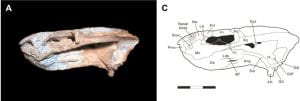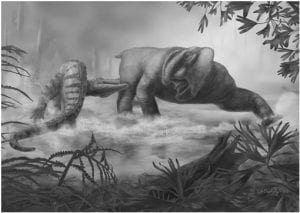
Feedback from my supervisors
Week three started off with a meeting with my three of my four supervisors – Armin, Professor Benton and Professor Emily Rayfield. My remaining supervisor was in the USA to do some work there so I would have to wait another week before I met him. Nevertheless, they all gave me feedback concerning the two tasks from last week. They were all quite pleased with the list of measurable cranial traits that I collected. On the other hand, I sensed that they wanted more testable hypotheses and to be honest I shared that sentiment as I felt I had not read enough. However, I assured them that I would continue my reading while I would be on holiday.
Having Professor Rayfield in the meeting was useful because she suggested something really useful. One of the hypotheses I had read suggested propaliny (also known as palinal motion), which is the horizontal movement of the lower jaw, could explain the success of anomodonts post the Permian-Triassic mass extinction. Professor Rayfield suggested that I could measure the length of the articular glenoid in relation to the quadrate condyle to assess the presence of propaliny in each species and compare whether this was more or less abundant in the remaining genera after the mass extinction event.
This led to discussions on what kind of skull images I needed to collect for each species. We settled on dorsal, lateral, occipital, ventral and palatal views of the skull as well as lateral and dorsal views of the mandible. Of course the availability of such images vary between species as some are better preserved than others. Even among the ones that are well preserved some views of the skull may not have been photographed. To see what kind of images I could consistently collect over all the anomodont species, we agreed on a trial run where I would try and collect these images for one species of anomodont from each family. From this trial run, I would also be able to see what measurements I could consistently take from the images. For example, if mandibles were not well preserved in anomodonts then I would have to discount any measurements to do with mandibles.

Increasing BME academics
Professor Benton also wanted me to look over a proposal he had written to asking for more funding for the BME diversity internship. Many internships in the past encouraged students to pursue Masters and PhDs so the idea was if Bristol could have a better funded BME internship with accommodation then BME diversity could be increased in academia. This speaks to the larger problem of BME diversity among academia as black professors only make up 5% of the 19000 professors in the UK. In the previous week, we had a meeting with two members from the student inclusion team on this proposal. Initially, we were looking for Bristol to provide accommodation for interns but to our surprise they had much greater aspirations of securing funding for these internships. They said that there is a real desire for such programs in Bristol so I have hope in the future this funding could be secured.
By this time, Professor Benton had set me up with my own blog. So I started thinking about what I wanted to write about. Obviously, I would write about my experience of the internship but I also wanted to make it easier for students in the future so I decided to also include some advice regarding the application, interview and the whole process leading up to the start of the internship. And thus the Bristol diversity Palaeobiology blog began!


